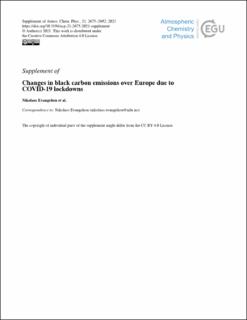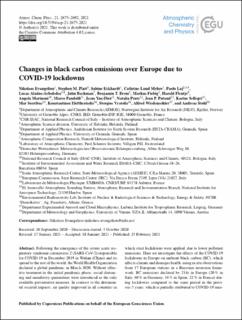Changes in black carbon emissions over Europe due to COVID-19 lockdowns
| dc.contributor.author | Evangeliou, Nikolaos | |
| dc.contributor.author | Platt, Stephen Matthew | |
| dc.contributor.author | Eckhardt, Sabine | |
| dc.contributor.author | Myhre, Cathrine Lund | |
| dc.contributor.author | Laj, Paolo | |
| dc.contributor.author | Alados-Arboledas, Lucas | |
| dc.contributor.author | Backman, John | |
| dc.contributor.author | Brem, Benjamin T. | |
| dc.contributor.author | Fiebig, Markus | |
| dc.contributor.author | Flentje, Harald | |
| dc.contributor.author | Marinoni, Angela | |
| dc.contributor.author | Pandolfi, Marco | |
| dc.contributor.author | Yus-Diez, Jesus | |
| dc.contributor.author | Prats, Natalia | |
| dc.contributor.author | Putaud, Jean-Philippe | |
| dc.contributor.author | Sellegri, Karine | |
| dc.contributor.author | Sorribas, Mar | |
| dc.contributor.author | Eleftheriadis, Konstantinos | |
| dc.contributor.author | Vratolis, Stergios | |
| dc.contributor.author | Wiedensohler, Alfred | |
| dc.contributor.author | Stohl, Andreas | |
| dc.date.accessioned | 2021-03-05T09:55:40Z | |
| dc.date.available | 2021-03-05T09:55:40Z | |
| dc.date.created | 2021-03-04T09:57:10Z | |
| dc.date.issued | 2021 | |
| dc.identifier.citation | Atmospheric Chemistry and Physics. 2021, 21, 2675-2692. | en_US |
| dc.identifier.issn | 1680-7316 | |
| dc.identifier.uri | https://hdl.handle.net/11250/2731794 | |
| dc.description.abstract | Following the emergence of the severe acute respiratory syndrome coronavirus 2 (SARS-CoV-2) responsible for COVID-19 in December 2019 in Wuhan (China) and its spread to the rest of the world, the World Health Organization declared a global pandemic in March 2020. Without effective treatment in the initial pandemic phase, social distancing and mandatory quarantines were introduced as the only available preventative measure. In contrast to the detrimental societal impacts, air quality improved in all countries in which strict lockdowns were applied, due to lower pollutant emissions. Here we investigate the effects of the COVID-19 lockdowns in Europe on ambient black carbon (BC), which affects climate and damages health, using in situ observations from 17 European stations in a Bayesian inversion framework. BC emissions declined by 23 kt in Europe (20 % in Italy, 40 % in Germany, 34 % in Spain, 22 % in France) during lockdowns compared to the same period in the previous 5 years, which is partially attributed to COVID-19 measures. BC temporal variation in the countries enduring the most drastic restrictions showed the most distinct lockdown impacts. Increased particle light absorption in the beginning of the lockdown, confirmed by assimilated satellite and remote sensing data, suggests residential combustion was the dominant BC source. Accordingly, in central and Eastern Europe, which experienced lower than average temperatures, BC was elevated compared to the previous 5 years. Nevertheless, an average decrease of 11 % was seen for the whole of Europe compared to the start of the lockdown period, with the highest peaks in France (42 %), Germany (21 %), UK (13 %), Spain (11 %) and Italy (8 %). Such a decrease was not seen in the previous years, which also confirms the impact of COVID-19 on the European emissions of BC. | en_US |
| dc.language.iso | eng | en_US |
| dc.rights | Navngivelse 4.0 Internasjonal | * |
| dc.rights.uri | http://creativecommons.org/licenses/by/4.0/deed.no | * |
| dc.title | Changes in black carbon emissions over Europe due to COVID-19 lockdowns | en_US |
| dc.type | Peer reviewed | en_US |
| dc.type | Journal article | en_US |
| dc.description.version | publishedVersion | en_US |
| dc.rights.holder | © Author(s) 2021. | en_US |
| dc.source.pagenumber | 2675-2692 | en_US |
| dc.source.volume | 21 | en_US |
| dc.source.journal | Atmospheric Chemistry and Physics | en_US |
| dc.identifier.doi | 10.5194/acp-21-2675-2021 | |
| dc.identifier.cristin | 1895527 | |
| dc.relation.project | EC/H2020/654109 | en_US |
| dc.relation.project | Norges forskningsråd: 275407 | en_US |
| cristin.ispublished | true | |
| cristin.fulltext | original | |
| cristin.fulltext | original | |
| cristin.qualitycode | 2 |
Tilhørende fil(er)
Denne innførselen finnes i følgende samling(er)
-
Publikasjoner fra Cristin - NILU [1363]
-
Vitenskapelige publikasjoner [1098]
Vitenskapelige artikler, kapitler og monografier.


